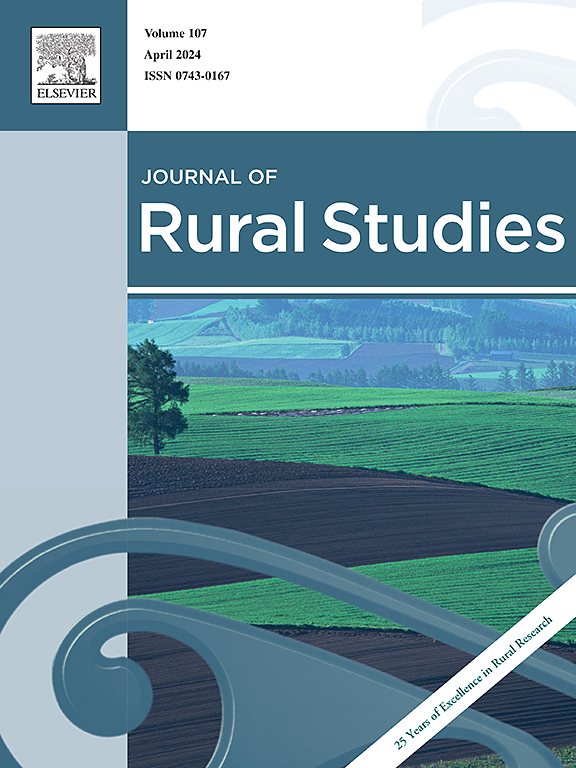Fisheries area-based partnerships in European multilevel governance: understanding embeddedness in organisational environments
IF 5.7
1区 社会学
Q1 GEOGRAPHY
引用次数: 0
Abstract
In the neo-endogenous development paradigm promoted by the European Union (EU), which seeks to reconcile local and supralocal objectives, local actors are expected to be meaningfully integrated within broader multilevel governance (MLG) structures, a condition often referred to as embeddedness in organisational environments. This article investigates three types of embeddedness of Fisheries Local Action Groups in Poland (FLAGs—area-based cross-sectoral partnerships operating in fisheries, aquaculture and related domains) within local and external organisational environments: institutional, structural and relational. We compare the results of A) content analysis of legal administrative documents about FLAGs (reflecting institutional embeddedness), B) the webometric analysis of hyperlinks to local and external organisations from the websites of FLAGs (reflecting structural embeddedness), with C) findings from semi-structured interviews conducted with FLAG representatives on direct relations with local and external stakeholders (reflecting relational embeddedness). The highest share of FLAGs linked to central government bodies, followed by local governments. Interviewees most frequently identified regional and local authorities, followed by local farmers and entrepreneurs as their main institutional contacts. This discrepancy may reflect the differentiated functions of open and direct communication channels. The links to EU institutions and foreign LAGs were the weakest. The observed pattern of ties indicates that while FLAGs exhibit a degree of local and external embeddedness, typical for MLG, their primary orientation in many cases appears to be securing EU funding rather than engaging in deliberative processes concerning sustainable fisheries policy. These characteristics of embeddedness allow two types of FLAGs to be identified: transformative pro-development and narrow grant-orientated.
欧洲多层次治理中的渔业区域伙伴关系:理解组织环境中的嵌入性
在欧盟(EU)推动的新内生发展范式中,寻求协调地方和超地方目标,期望地方行动者有意地融入更广泛的多层次治理(MLG)结构,这种情况通常被称为组织环境中的嵌入性。本文调查了波兰渔业地方行动小组(在渔业、水产养殖和相关领域开展活动的基于flag的区域跨部门伙伴关系)在当地和外部组织环境中的三种嵌入性:体制、结构和关系。我们比较了以下结果:A)旗帜的法律行政文件的内容分析(反映制度嵌入性),B)旗帜网站上指向本地和外部组织的超链接的网络计量分析(反映结构嵌入性),以及C)旗帜代表与本地和外部利益相关者直接关系的半结构化访谈结果(反映关系嵌入性)。与中央政府机构相关的国旗比例最高,其次是地方政府。受访者最常指出的是地区和地方当局,其次是当地农民和企业家是他们主要的机构联系人。这种差异可能反映了公开和直接沟通渠道的不同功能。与欧盟机构和外国lag的联系最为薄弱。观察到的关系模式表明,虽然旗国表现出一定程度的地方和外部嵌入性,这是多边渔业组织的典型特点,但在许多情况下,它们的主要方向似乎是获得欧盟的资助,而不是参与有关可持续渔业政策的审议进程。嵌入性的这些特征允许识别两种类型的旗帜:变革性的促进发展和狭隘的赠款导向。
本文章由计算机程序翻译,如有差异,请以英文原文为准。
求助全文
约1分钟内获得全文
求助全文
来源期刊

Journal of Rural Studies
Multiple-
CiteScore
9.80
自引率
9.80%
发文量
286
期刊介绍:
The Journal of Rural Studies publishes research articles relating to such rural issues as society, demography, housing, employment, transport, services, land-use, recreation, agriculture and conservation. The focus is on those areas encompassing extensive land-use, with small-scale and diffuse settlement patterns and communities linked into the surrounding landscape and milieux. Particular emphasis will be given to aspects of planning policy and management. The journal is international and interdisciplinary in scope and content.
 求助内容:
求助内容: 应助结果提醒方式:
应助结果提醒方式:


